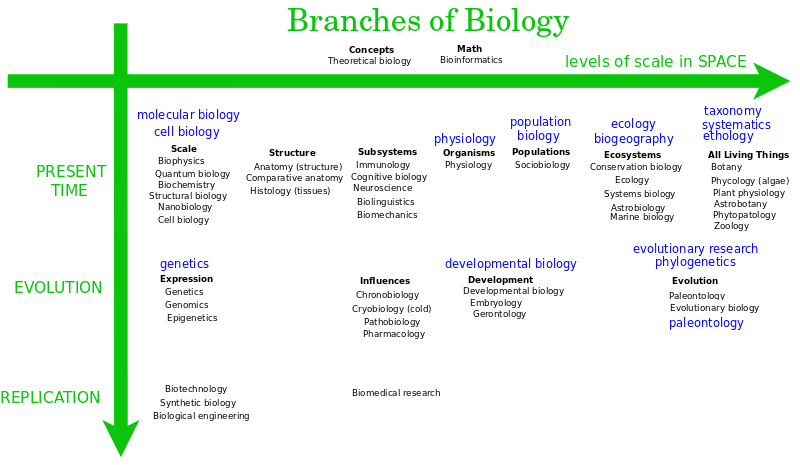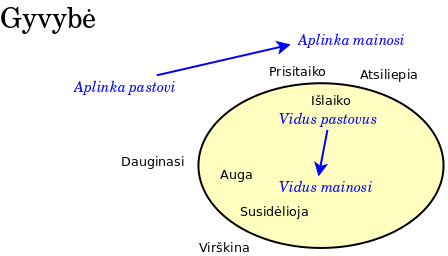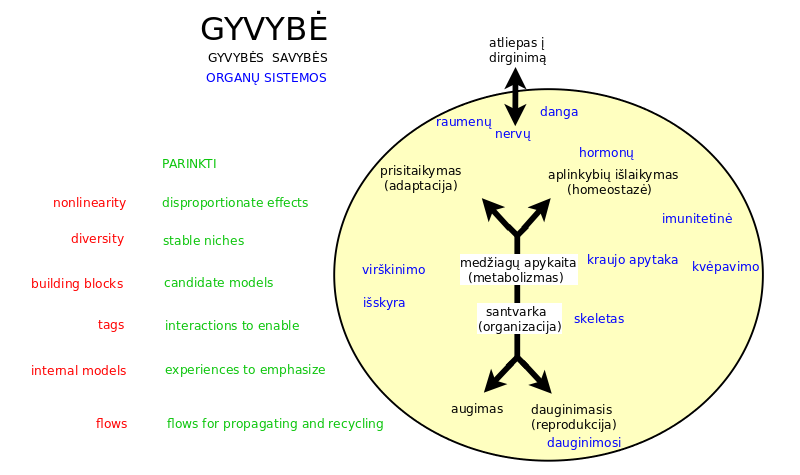- MathNotebook
- MathConcepts
- StudyMath
- Geometry
- Logic
- Bott periodicity
- CategoryTheory
- FieldWithOneElement
- MathDiscovery
- Math Connections
Epistemology
- m a t h 4 w i s d o m - g m a i l
- +370 607 27 665
- My work is in the Public Domain for all to share freely.
- 读物 书 影片 维基百科
Introduction E9F5FC
Questions FFFFC0
Software
See: Biology discovery, Information
生命
- Prasmingai apibrėžti biologinę gyvybę.
- Brėžiniu išdėstyti biologijos šakas.
- Brėžiniu išdėstyti kūno įvairias apytakas, posistemes.
- Gyvybę susieti su ketverybe išmąsčius ryšius tarp pastovios aplinkos ir besimainančio vidaus ir besimainančios aplinkos ir pastovaus vidaus.
- Pasiskaityti apie DNR.
- What costs do selfishness and nonselfishness incur?
- Does a system of top down evolution of an environment evolve by the tuning of pressure points, as with divisions of everything? In the way that a global workspace divides itself in the brain?
- Evolution of an individuals' genes? Or evolution of a populations' genes? To whom do the genes belong and in what way
- Evolution (as of the brain's hemispheres) reflects top-down constraints, not bottom-up implementation. Relate this to the three modes of evolution.
- Why are people designed to live until 60 or 80 or 120 years but life expectancy was much shorter than that for most of human history?
- Compare: Mind (intentionality) and life (interest).
- Proteins - mechanical "body". DNA - informational "mind". What is the heart and will?
Readings
How Life Arose on Earth and How a Singularity Might Bring It Down
- Purpose of life is to hydrogenate carbon dioxide and get methane. (Go from a higher energy state to a lower energy state when there is no direct path.) Methane is a tetrahedron {$\textrm{CH}_4$}.
- Mike Russell of JPL
- Peter Kropotkin
Definition of life
- Life is based on the fixed points in the total environment, the natural places for homeostasis.



Characteristics of Life
- Homeostasis: regulation of the internal environment to maintain a constant state; for example, sweating to reduce temperature
- Organization: being structurally composed of one or more cells – the basic units of life
- Metabolism: transformation of energy by converting chemicals and energy into cellular components (anabolism) and decomposing organic matter (catabolism). Living things require energy to maintain internal organization (homeostasis) and to produce the other phenomena associated with life.
- Growth: maintenance of a higher rate of anabolism than catabolism. A growing organism increases in size in all of its parts, rather than simply accumulating matter.
- Adaptation: the ability to change over time in response to the environment. This ability is fundamental to the process of evolution and is determined by the organism's heredity, diet, and external factors.
- Response to stimuli: a response can take many forms, from the contraction of a unicellular organism to external chemicals, to complex reactions involving all the senses of multicellular organisms. A response is often expressed by motion; for example, the leaves of a plant turning toward the sun (phototropism), and chemotaxis.
- Reproduction: the ability to produce new individual organisms, either asexually from a single parent organism or sexually from two parent organisms.
Literature
Notes
- Can think of evolutionary variation as a transportation across time to a population with a different distribution of genes and a new environment for that population. Gene distribution and environment change in parallel.
- From an evolutionary point of view, the survival of the group takes precedence over the survival of the individual. The argument is that the group is a more general entity and develops prior to the individual. Thus the group has developed mechanisms to eliminate destructive individuals. Thus individual entities evolve to compete primarily in ways that are sanctioned by the group. Exceptions are likely to be punished and thus must first of all address the possibility of punishment as this is the greatest threat to the individual. For example, by this logic, cells that do not undergo programmed death will be killed. Also, this has the consequence of accelerating evolution along very distinct channels of sanctioned competition. And it also supposes that all of life by design supports the whole of life, as a given, or is punished severely. The overall idea is the ambiguity of genetic purpose, the fact that genes serve not just the individual, but also their cells, their organs, their social units, their species, their ecosystems and all of life. Within this ambiguity, what entities are relevant for reproducing the gene?
- In life, the accidental can become the norm. Thus the theory of probability and statistics is essential for life.
- In life, a gene serves a variety of entities. These may be considered as different models for interpreting a theory.
- In life, through evolution there is an accumulated deliberateness of the existing system. This deliberateness is expressed as the decreasing of entropy. What is happening here?
- Some species are highly dependent on specific ecosystems and even dependent on a web of very particular species on which they feed and with which they interact. But other species (such as humans) are able to live in very different ecosystems and don't depend on any particular species. Yet humans may depend on very particular microorganisms, which may, however, be carried by humans wherever they go.
- Gyvybė remiasi daugiaprasmybe, o tai skirtingų valių suvedimas. Daugiaprasmybę grindžia tikimybę, atsitiktinumą, entropiją, ir ją palaiko stebūklai, malda, šviesuolių bendrystė.
Duality
- In DNA, length of G+C = length of A+T, making them interchangeable.
Reproducibility
- Experimental science is based on reproducibility. Life likewise is based on reproducibility.
Womb
- Organizes passes from utero to real world and then creates a new utero, a chamber for fostering life.
- The womb-love (the environment) complements life (the organism).
Sperm
- Sperm, seed is information?
Three-cycle
- The α-helix has a period of three or four, which recalls the three-cycle.
Biology
- Systems biology. Ralph Philips. Physical biology of the cell.
- Cell boundaries make for an isolated system.
